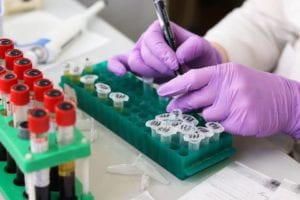Rare Community Profiles

Rare Community Profiles is a new Patient Worthy article series of long-form interviews featuring various stakeholders in the rare disease community, such as patients, their families, advocates, scientists, and more.
What’s Your SMthing?: Pam’s Efforts to Create a Culture of Support and Awareness for Systemic Mastocytosis
Salicylates are natural chemicals found in various plants; they may also be used in manufactured products. If I provided a list, you might be shocked at how widespread salicylate use is:
Blueberries. Avocadoes. Peppermints. Mushrooms. Any medication or face wash with salicylic acid. White willow bark. Any products with methyl salicylate. Coffee. Cauliflower. Pine nuts. Broccoli. Cucumber. Radishes. Spinach. Zucchini. Eggplant. Bell peppers. Tomatoes. Fruit juice. Apples. Berries. Grapes. Peaches. Plums. Thyme. Rosemary. Paprika. Garam masala. Curry. Alcohol. Licorice. Tea. Tarragon. Turmeric. Peanuts. Cashews. Certain perfumes and fragrances. Cosmetics…and that’s not even an exhaustive list.
53-year-old Pam’s life changed in 2012 when she suddenly became allergic to hundreds of common items. After a tough and isolating diagnostic journey, Pam was diagnosed with a rare mast cell disorder called systemic mastocytosis.
This disorder causes excess mast cells (a type of white blood cell) to accumulate in the body. When facing a trigger, these mast cells react, causing symptoms that reflect an allergic reaction.
For Pam, salicylates are her main trigger.
Despite the fact that her systemic mastocytosis makes it impossible for Pam and her husband to travel, she has faced her condition with a smile and a reminder to others that they are not alone. From writing a book about mast cell disorders—to connect with others in a less clinical, less technical way— and launching an online support group to participating in What’s Your SMthing?, Pam lives every day trying to make a difference.
Pam’s Story
For most of her life, Pam had considered herself to be relatively healthy. She lived a happy life in Indiana with her husband, their three daughters, and a menagerie of pets that brightened every day. When she turned 40 years old, however, her health took a turn. Her hair began falling out; her fingernails turned thin and flaky. Every day, her body felt more and more fatigued.

It seemed like lupus might be the cause—and after a rheumatologist visit, where testing showed that Pam had elevated ANA, Pam was convinced. But after one week of plaquenil and additional testing showing her SED rate, the doctor changed their mind. Says Pam:
“I was told that it might be a mixed connective tissue disease, but to stay on plaquenil for now until we figured something out. Within the next few weeks, I had an anaphylactic reaction to the treatment. I had a rash from my knees to my neck and my throat swelled up. The reaction was life-threatening and it was terrifying.”
This led Pam to pursue additional diagnostic care at an allergist/immunologist. She was told that the doctors believed that she had mastocytosis. But to be sure, Pam would need to undergo a bone marrow biopsy. She shares:
“I had three attempted bone marrow biopsies, but they couldn’t get through the bone. So I had to go to the hospital for a CT guided bone marrow biopsy. Even then, the doctor had to change the drill bit! I’ve learned since then that systemic mastocytosis can harden your bones.”
While this could have given Pam answers, there was an issue. Unfortunately, the oncologist was not familiar with a bilateral biopsy: this is the best way to identify mastocytosis by allowing doctors to check for mast cell clusters on a wider scale. Pam’s unilateral biopsy did not hit any mast cell clusters, so her mastocytosis test came out negative.
You’ve had this the entire time…
Six years ago, Pam was recommended by her immunologist to see a gastroenterologist to have an upper GI endoscopy. Pam was terrified; her body was incredibly reactive, but the doctor convinced her that she’d be okay. Because no mast cell staining was done, her testing came back negative.
Five years later, her symptoms had worsened drastically. Every night after dinner, her throat tightened. She was taking mast cell stabilizers at the highest doses. Sometimes, she spent her time scrolling through educational information on eosinophilic esophagitis, wondering if she was missing something.
Would another upper GI procedure do the trick? No. Once again, no mast cell staining was done. Frustrated, Pam asked her doctor what was happening. He asked pathology to have another person stain her samples. Says Pam:
“He finally told me that he could see signs of mastocytosis in every single biopsy. When he asked the pathology office to re-stain the samples from five years ago, it came back positive. The immunologist told me that I’ve had this the entire time.”
10 years of searching. And finally, she had an answer. Very shortly after, Pam began XOLAIR treatment. She says:
“If I had started this years ago, maybe I would be in a much better place than I am today. I also sometimes have a kind of trauma response to my diagnosis. After ten years, I was told, ‘here’s your answer, good luck.’ Over that period, I had one doctor that fired me because my tryptase wasn’t elevated. In 10% of people with systemic mastocytosis don’t have elevated tryptase. I’m so thankful that my doctor now recognized that.”
What is Systemic Mastocytosis (SM)?
Systemic mastocytosis is a rare blood disorder characterized by excess mast cells. Normally, mast cells live in every organ and play a role in our immune health. They fight bacteria and infections by releasing mediators—such as histamine, leukotrienes, and cytokines. In most cases KIT mutations cause systemic mastocytosis, which lead to the over production of mast cells. Symptoms may include:
- Muscle and bone pain
- Nausea and vomiting
- Anemia (low red blood cell count)
- Low blood pressure
- Shortness of breath
- Severe fatigue and malaise
- An enlarged spleen, liver, and lymph nodes
- Diarrhea and abdominal pain
- Gastroesophageal reflux
- Hives
- Flushed or itchy skin
- Congestion
- Anaphylaxis (severe allergic reaction)
There are no cures for systemic mastocytosis.
Managing Systemic Mastocytosis
Throughout the diagnostic journey, Pam and her family weren’t sure if they would need to give up their pets. They made a rule: no animals in the bedroom. Since then, Pam has discovered other ways to manage her condition. She explains:
“I’ve seen people with SM who can eat whatever they want as long as they take an antihistamine. I’m the opposite. I have to be very aware of what’s in the products I use and constantly aware of what I’ve eaten. Right now, I have a low-histamine and low-salicylate diet. But sometimes I still have reactions, so I keep a food diary where I write down, every day, what I eat, my medications, reactions, and notes. I can look back and say, ‘Ok, maybe it was this.’”
Pam also wears a mask to protect herself against potential triggers. This has sometimes been difficult and she notes that people sometimes stare:
“I wore a mask for 10 years, I wore a mask during COVID, and now that masks aren’t always required, I’m still wearing one. People give me a lot of strange looks and comments. But I want the general population to understand that for many people with mastocytosis and other rare conditions, we’re doing what we need to do to take care of ourselves.”
A Culture of Support
Throughout her journey, Pam credits her husband for being such a strong support system. She describes them as being in the trenches together: a steadfast partnership.

At the same time, she shares:
“Online communities have been necessary in finding support from people who have been there. When I first got sick, I went to the Mast Cell Society’s Facebook group and got so much good advice. When you’re starting, you’re in the middle of the storm: no idea what is up, down, left, or right. It’s good to connect with other people who can say, ‘This gets better. Hang in there. Try this.’”
After reacting to their water reverse osmosis system, for example, Pam turned to her online community. Someone recommended that she try distilled water; this seemingly small change was incredibly impactful.
While she has found comfort in these groups, Pam also launched her own Facebook group for mast cell disorders. She explains that some Facebook groups are private, but she wanted to ensure that people could access the information and stories in her group:
“I want people to understand mast cell disorders, but they can’t care about something that they don’t know about. We need a cure and part of that means showing people what is going on. SM can be isolating. I’ve lost friends to suicide because of mast cell diseases and that is heartbreaking. By making my group open, I’m ensuring that we’re raising awareness to the fullest extent possible.”
What’s Your SMthing?
The What’s Your SMthing? Gallery, spearheaded by Blueprint Medicines, recently went live, showcasing submissions to a campaign that invited people to create and share art that highlights their systemic mastocytosis journey. Through poems, photographs, knitting, and other creative endeavors, this community came together for connection and empowerment.
Pam submitted a photo entitled “Summer at the Pond.” In it, a dragonfly perches gently on the end of a plant leaf, its wings crystalline in the sun. The background is a blend of orange, white, and green: koi fish swimming through the pond. She explains:
“I can’t travel, so we built a pond in our backyard. We made our own little sanctuary back there. The dragonfly is a representation of that peace we’ve found. It shows that you don’t have to leave your home or travel far to find beauty in the world. Mastocytosis can make life extremely hard. But in these moments, I remember just how beautiful everything can be.”








